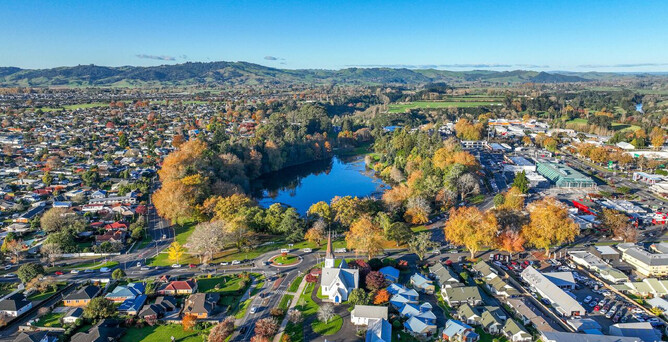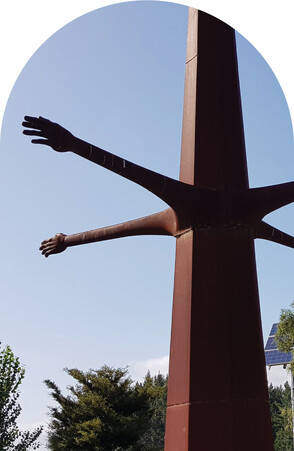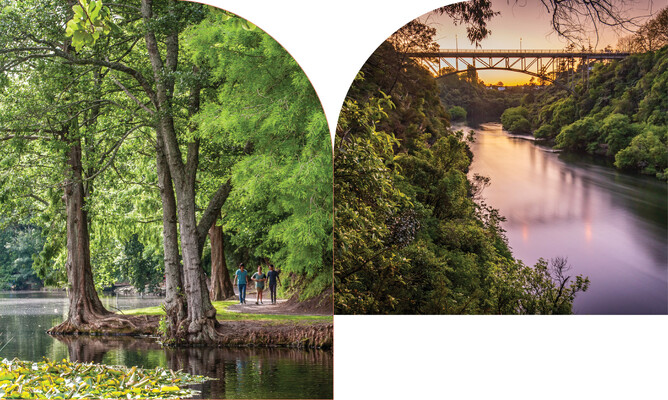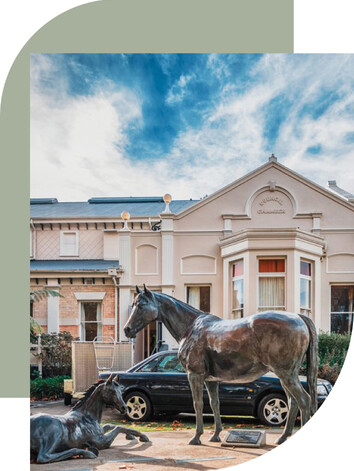In the footsteps of our forebears
Cambridge's rich heritage includes thriving Māori communities before European settlement, land wars and post-colonial building and development. Here are 10 quick snippets showcasing the history of our town and its people.
Horotiu Pā
Horotiu Pā was a huge Māori settlement that once occupied the whole Cambridge central business district. The name Horotiu connects back to Rakatāura, the tohunga (navigating priest) of the Tainui waka, a double-hulled voyaging canoe that travelled to Aotearoa New Zealand from Polynesia around 800 years ago. Rakatāura named the Waikato River ‘Horotiu’, meaning ‘swift currents’. Over generations, Horotiu Pā was a safe haven for many tribes of Tainui. It was a place of refuge during the attacks by Hongi Hika and the Ngāpuhi tribe in the 1820s. Horotiu Pā fell when the British Crown invaded Waikato in 1863-1864. Te Rongopai (the message of peace) created by Brett Graham, was erected in acknowledgement of the many pā located along the gully where the expressway runs. Source: Te Ara Wai Journeys
The iconic water tower
When you drive down Hamilton Road, you’ll see the iconic Cambridge Water Tower located in front of the Resthaven Retirement Village on the Payne Park reserve. The tower has a fascinating backstory, with public meetings held in the early 1880s to discuss the need for a municipal water supply to meet the growing demands of the town's residents and businesses. In 1902, a water supply project was approved, and construction of the 24m high water tower structure began. The tower was built with the help of Robert Morse, William George Tucker, and an old black horse named Darkie who was used to raise bricks by a pulley. It officially opened in 1903 and supplied the Cambridge township with water until
around 1926.
The Anchor Dairy Factory
Henry Reynolds established the Anchor Dairy Factory in Pukekura in 1886. Reynolds used an American butter recipe to create a longer lasting butter compared to others. The longevity of Anchor butter may have been due to the breed of cows used. While Friesian cows were prevalent in America, Jersey cows were more common in New Zealand, and their milk has a higher fat percentage, which increases its shelf life. The butter had an excellent taste, thanks to the clean, pasture-based farming of the Waikato region. Source: Te Ara Wai Journeys
Station 44
Before 1904, fires in Cambridge were fought using buckets and hand-held fire grenades. Wooden buildings and limited water meant fire caused significant property damage. There were at least 32 fires between 1881 and 1888, and a big one in 1889 that destroyed several businesses. The new water tower in 1903 finally provided a reliable supply of water, so the Borough Council approved establishing the Cambridge Volunteer Fire Brigade in May 1904. The brigade was formed, funds were raised, the station was constructed by volunteers, and equipment was acquired. The Fire Brigade officially opened on 24 August 1904 and was a source of much pride for the town.
Karāpiro Dam
Two successive hydroelectric dams have been built near Karāpiro, using the fast-flowing rapids of the Waikato River to generate power. Horahora Power Station was completed in 1913. The largest power development in New Zealand at the time, it was built to power the Waihī mines. The government purchased the station in 1919. It provided the bulk of the northern North Island’s electricity until the 1930s, when other dams opened. Construction on the larger Karāpiro Dam was started in 1940, but materials and labour shortages during World War II meant it was not completed until 1947. Karāpiro Dam submerged the Horahora power station and village – these lie on the lake floor, where the Horahora Bridge crosses Lake Karāpiro. Today, Karāpiro is one of eight hydro dams generating electricity along
New Zealand’s longest river.
Impacts of the dam
A number of special places were flooded when the two dams were built, in the 1910s and 1940s. These include the sites of Māori pā (settlements), kāinga (houses), mahinga kai (food gathering places), māra kai (gardens), and wāhi tapu (sacred places) that were once situated near the Waikato River. The tangata whenua (indigenous people of these lands) had burial caves in the cliffs that once lined the river. These were submerged as well. While Pākehā (Europeans) were celebrating the Karāpiro Dam opening, the tangata whenua were on boats, retrieving the bones of their tūpuna (Māori ancestors) from the water. They reinterred the displaced bones in a safe area.
Source: Te Ara Wai Journeys
Lake Te Koo Utu – the washbowl
Before the coming of Pākehā (Europeans), the natural resources of Lake Te Koo Utu supported a thriving Māori community. Many hapū (subtribes) lived here. There were pā (Māori settlements) on the hills around the lake. Nearby, the residents cultivated gardens. Lake Te Koo Utu was a plentiful source of kōura (freshwater crayfish) and fish. Pinau (a native grass), harakeke (flax) and raupō (bullrush) for weaving and thatching grew on the shores. Source: Te Ara Wai Journeys
The Victoria Bridge
The connection of Cambridge to Leamington and Te Awamutu was an important link in the early roading system. The first bridge completed in 1871 was destroyed by a flood in 1875 and its replacement, a wooden truss girder bridge called the “Red Bridge” was showing signs of advanced deterioration. In 1899, Mayor W.F. Buckland decided a new high-level bridge over the Waikato River was needed. The steel arch bridge was designed by the eminent American engineer John Alexander Low Waddell of Kansas City. The bridge, with its impressive design, stretches 462 ft (141m) and features a central arch of 290 ft (88m). It is 17 ft (5.2m) wide and constructed using over 330 tonnes of steel and 20,000 rivets.It still stands proudly after 150 years.
Equine capital of New Zealand
Cambridge Stud owner and master bloodstock breeder, the late Sir Patrick Hogan, was a world leader in the equine industry and put Cambridge (and New Zealand) on the map for thoroughbred breeding. Against expert advice, Sir Patrick Hogan followed his intuition and bought the young Irish stallion Sir Tristram sight unseen. This proved one of the greatest success stories in thoroughbred breeding, as Sir Tristram became a sire of champions. In 1972, Sir Patrick and Lady Justine sold their Fencourt Road property and moved to Discombe Road in 1976. Together, they built Cambridge Stud to become the thoroughbred showplace of New Zealand, and one of the most successful studs in Australasian thoroughbred history, not only home to Sir Tristram but also his incomparable son Zabeel and generations of superb mares, broodmares and yearlings. Sir Patrick died in January 2023 at the age of 83, and his legacy lives on as a legend in horse breeding and racing in New Zealand.
The town of champions
In 2003, Cambridge established a Walk of Fame to honour exceptional achievers in the town. Those recognised receive a special plaque on Duke Street. In 2003, 24 sports achievers were inducted into the Cambridge Sports Walk of Fame. In 2006, five more sportspeople were added, followed by four in 2009 and one in 2014. The town also pays homage to the New Zealand equine industry with 12 equine mosaics installed throughout Victoria Street. These mosaics commemorate the achievements of notable racing champions such as Foxbridge, Sir Tristram, Zabeel, Charisma, and others. Additionally, Michelle Farrell's Mare and Foal statue was placed outside the Cambridge Town Hall that same year.
Cambridge Town Hall
Founded in April 1909, the Cambridge Town Hall has stood as a proud symbol of the town's rich history and heritage for over a century. Led by Mayor W.F. Buckland, the grand opening ceremony marked the beginning of a long and storied journey for this iconic building. Throughout the years, the Town Hall has played host to a wide range of events, from musical and theatrical performances to important civic gatherings. It has served as a fitting backdrop for numerous milestone occasions, including the end of World War II celebrations, and a special lunch with Queen Elizabeth II and Prince Philip in 1954. The Town Hall has welcomed many distinguished guests, including Governor Generals, war heroes, and sporting champions. It has also served a multitude of purposes, including a picture theatre, a dance hall, and an emergency hospital during the 1918 influenza epidemic.
A tale of two kings
The door grilles on the old Post Office building (now Alpino Restaurant) are unique in New Zealand. No other building in New Zealand has two kings on its façade.
The longest-standing landmark in Cambridge
St Andrew’s Anglican Church stands as a distinctive and beloved landmark in our town. The original church, located at the rear, was constructed in 1873 and is the oldest surviving building in Cambridge. It was initially built with a steeple and bell. The main church that we recognise today was built in 1881 using heart kauri and cost £1570 to construct. The entire town had a holiday when it was consecrated on 31 August 1881.
The chimes of Cambridge
The Cambridge Clock Tower is one of the most noticeable assets in Cambridge and its distinctive chimes can be heard across town. The clock was supplied by Littlejohn and Sons of Wellington in 1908 and was originally in a tower on the Post Office (now Alpino Restaurant). Cracks started to appear in its tower and the clock was reconstructed in a new tower at its current location in 1934. It continues to be wound by hand twice a week.
Discover a treasure trove of other insights, artefacts, photographs and taonga that showcase the people and passions that shaped Cambridge at the Cambridge Museum.
Visit cambridgemuseum.org.nz
for more information.
